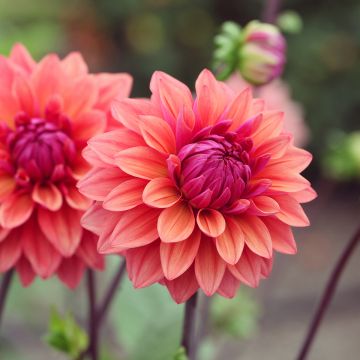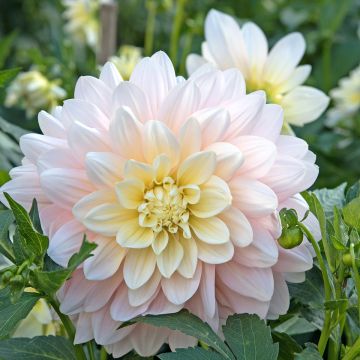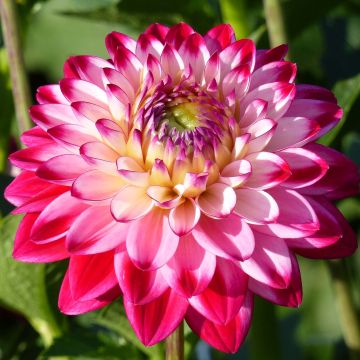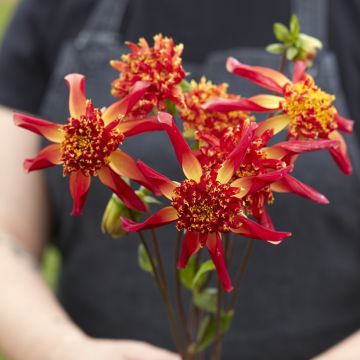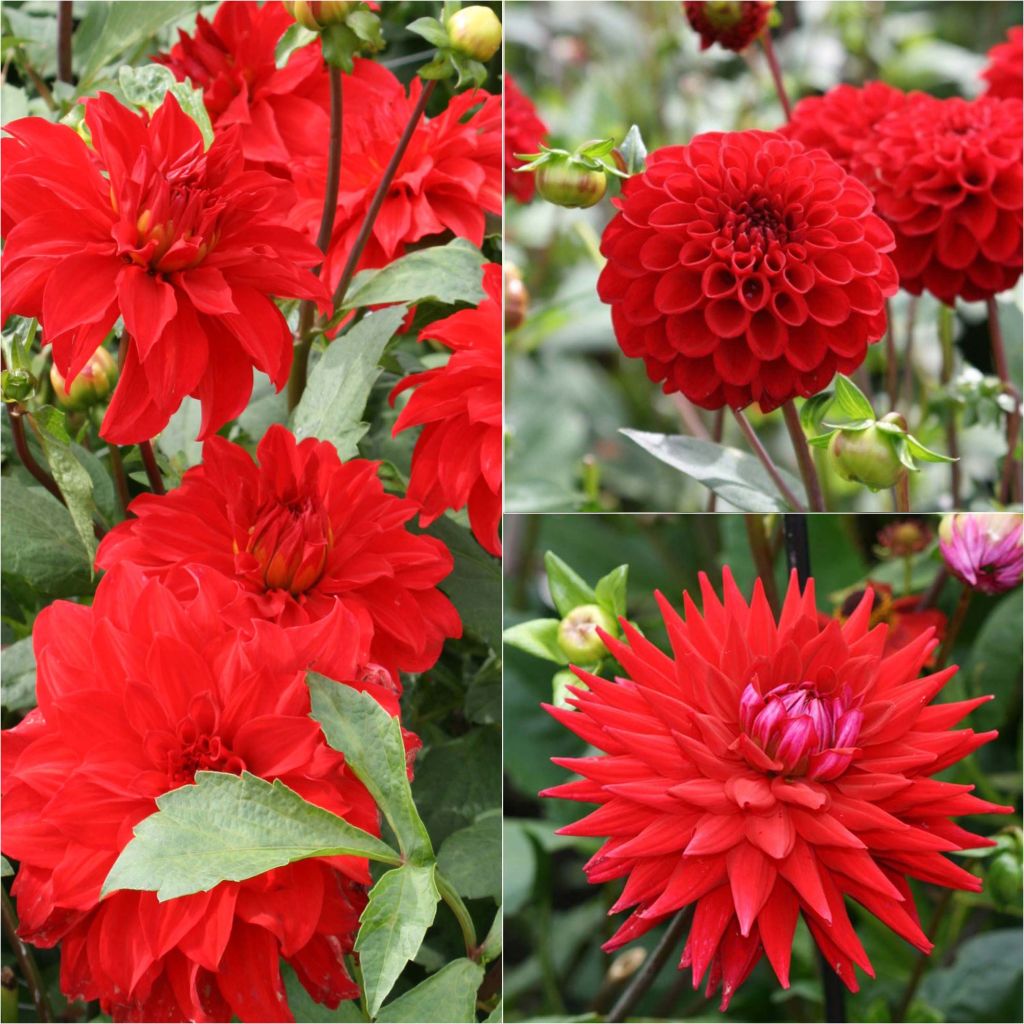

Collection of 3 dahlias for bouquets, red tones
Collection of 3 dahlias for bouquets, red tones
Dahlia Red Fox, Witteman's Best, Barbarossa
Order received in good condition, very satisfied, thank you.
Isabellle, 02/03/2022
This plant carries a 6 months recovery warranty
More information
We guarantee the quality of our plants for a full growing cycle, and will replace at our expense any plant that fails to recover under normal climatic and planting conditions.
From €5.90 for pickup delivery and €6.90 for home delivery
Express home delivery from €8.90.

Does this plant fit my garden?
Set up your Plantfit profile →
Collection items (3 plants)
Description
A collection of 3 Dahlias for dazzling red bouquets! Their flowers, with varying shapes, double or bristly petals, or even large honeycomb pompoms, bloom abundantly from July to October. We appreciate the power of the red color scheme that delights the eye, magnificent in full sun in flower beds. These Dahlias, carried by long stems, are of course splendid in homemade bouquets, with gray foliage and white roses for example.
This collection consists of:
-1x Ball Dahlia 'Red Fox': 8 cm (3in) wide flowers, with petals or ligules forming a dense ball, precisely organized in honeycombs, a dazzling red, very uniform, with a velvety appearance. The plant forms a leafy clump about 1 m (3ft) tall.
-1x Semi-cactus Dahlia 'Witteman's Best' (synonym Superba): on 1.30 m (4ft) stems, flowers 15 to 20 cm (6 to 8in) wide filled with pointed petals, a crimson red, darkened at the heart with more purplish hues.
1x Giant Decorative Dahlia 'Barbarossa': 20 cm (8in) flowers, round and flat in shape, semi-double or sometimes double, offering a superb scarlet red color, very homogeneous. Perched on long stems over a metre high, they give a special relief to the background of flower beds. Height: 1.30 m (4ft), purplish stems.
To encourage flowering again, be sure to remove faded flowers, or even better, regularly make large colorful bouquets by associating them with other varieties. Perched on long stems over a meter high, the red flowers of the dahlias in this collection give a special relief to the background of flower beds. With their dazzling flowers, the dahlias in this collection go particularly well with white, blue, or violet flowers (Salvia Black and Blue). They also go perfectly with grasses, shrubby wormwoods, and cineraria, as well as with helenias for example, and also allow for enhancing bouquets until late in the season.
As a star plant for borders and herb gardens, Dahlias confidently accompany the most beautiful flowers but are also appreciated alongside vegetable plants. In Mexico, this tuberous plant was first cultivated as a root vegetable for consumption. But its poor taste qualities assigned it the rank of ornamental plant. Since then, the interest in their beautiful exuberance has never waned.
Report an error about the product description
Plant habit
Flowering
Foliage
Botanical data
Dahlia
Red Fox, Witteman's Best, Barbarossa
Asteraceae
Cultivar or hybrid
Other Dahlias
Planting and care
Plant your dahlias during the spring days in a deeply worked soil, enriched for example with crushed horn or dehydrated blood. Place your tuber and crumble the soil well to fill without air pockets. Your dahlia should be covered with 6 cm (2in) of soil. At the end of planting, pour one litre of water. Water regularly for the first 6 weeks to aid in rooting. Dahlias are sensitive to cold, they need to be overwintere under protection. In November, the first frosts will blacken the foliage, it's time to dig them up. Carefully unearth the tubers. Remove as much soil as possible. Let the foliage dry so that the tuber can replenish its reserves. When the foliage is dry, cut the stems to 10 cm (4in) from the tuber. Spread your bulbs in a crate on a newspaper. Store in a frost-free, dry, cool, and dark place.
Planting period
Intended location
Care
-
, onOrder confirmed
Reply from on Promesse de fleurs
Haven't found what you were looking for?
Hardiness is the lowest winter temperature a plant can endure without suffering serious damage or even dying. However, hardiness is affected by location (a sheltered area, such as a patio), protection (winter cover) and soil type (hardiness is improved by well-drained soil).

Photo Sharing Terms & Conditions
In order to encourage gardeners to interact and share their experiences, Promesse de fleurs offers various media enabling content to be uploaded onto its Site - in particular via the ‘Photo sharing’ module.
The User agrees to refrain from:
- Posting any content that is illegal, prejudicial, insulting, racist, inciteful to hatred, revisionist, contrary to public decency, that infringes on privacy or on the privacy rights of third parties, in particular the publicity rights of persons and goods, intellectual property rights, or the right to privacy.
- Submitting content on behalf of a third party;
- Impersonate the identity of a third party and/or publish any personal information about a third party;
In general, the User undertakes to refrain from any unethical behaviour.
All Content (in particular text, comments, files, images, photos, videos, creative works, etc.), which may be subject to property or intellectual property rights, image or other private rights, shall remain the property of the User, subject to the limited rights granted by the terms of the licence granted by Promesse de fleurs as stated below. Users are at liberty to publish or not to publish such Content on the Site, notably via the ‘Photo Sharing’ facility, and accept that this Content shall be made public and freely accessible, notably on the Internet.
Users further acknowledge, undertake to have ,and guarantee that they hold all necessary rights and permissions to publish such material on the Site, in particular with regard to the legislation in force pertaining to any privacy, property, intellectual property, image, or contractual rights, or rights of any other nature. By publishing such Content on the Site, Users acknowledge accepting full liability as publishers of the Content within the meaning of the law, and grant Promesse de fleurs, free of charge, an inclusive, worldwide licence for the said Content for the entire duration of its publication, including all reproduction, representation, up/downloading, displaying, performing, transmission, and storage rights.
Users also grant permission for their name to be linked to the Content and accept that this link may not always be made available.
By engaging in posting material, Users consent to their Content becoming automatically accessible on the Internet, in particular on other sites and/or blogs and/or web pages of the Promesse de fleurs site, including in particular social pages and the Promesse de fleurs catalogue.
Users may secure the removal of entrusted content free of charge by issuing a simple request via our contact form.
The flowering period indicated on our website applies to countries and regions located in USDA zone 8 (France, the United Kingdom, Ireland, the Netherlands, etc.)
It will vary according to where you live:
- In zones 9 to 10 (Italy, Spain, Greece, etc.), flowering will occur about 2 to 4 weeks earlier.
- In zones 6 to 7 (Germany, Poland, Slovenia, and lower mountainous regions), flowering will be delayed by 2 to 3 weeks.
- In zone 5 (Central Europe, Scandinavia), blooming will be delayed by 3 to 5 weeks.
In temperate climates, pruning of spring-flowering shrubs (forsythia, spireas, etc.) should be done just after flowering.
Pruning of summer-flowering shrubs (Indian Lilac, Perovskia, etc.) can be done in winter or spring.
In cold regions as well as with frost-sensitive plants, avoid pruning too early when severe frosts may still occur.
The planting period indicated on our website applies to countries and regions located in USDA zone 8 (France, United Kingdom, Ireland, Netherlands).
It will vary according to where you live:
- In Mediterranean zones (Marseille, Madrid, Milan, etc.), autumn and winter are the best planting periods.
- In continental zones (Strasbourg, Munich, Vienna, etc.), delay planting by 2 to 3 weeks in spring and bring it forward by 2 to 4 weeks in autumn.
- In mountainous regions (the Alps, Pyrenees, Carpathians, etc.), it is best to plant in late spring (May-June) or late summer (August-September).
The harvesting period indicated on our website applies to countries and regions in USDA zone 8 (France, England, Ireland, the Netherlands).
In colder areas (Scandinavia, Poland, Austria...) fruit and vegetable harvests are likely to be delayed by 3-4 weeks.
In warmer areas (Italy, Spain, Greece, etc.), harvesting will probably take place earlier, depending on weather conditions.
The sowing periods indicated on our website apply to countries and regions within USDA Zone 8 (France, UK, Ireland, Netherlands).
In colder areas (Scandinavia, Poland, Austria...), delay any outdoor sowing by 3-4 weeks, or sow under glass.
In warmer climes (Italy, Spain, Greece, etc.), bring outdoor sowing forward by a few weeks.







































